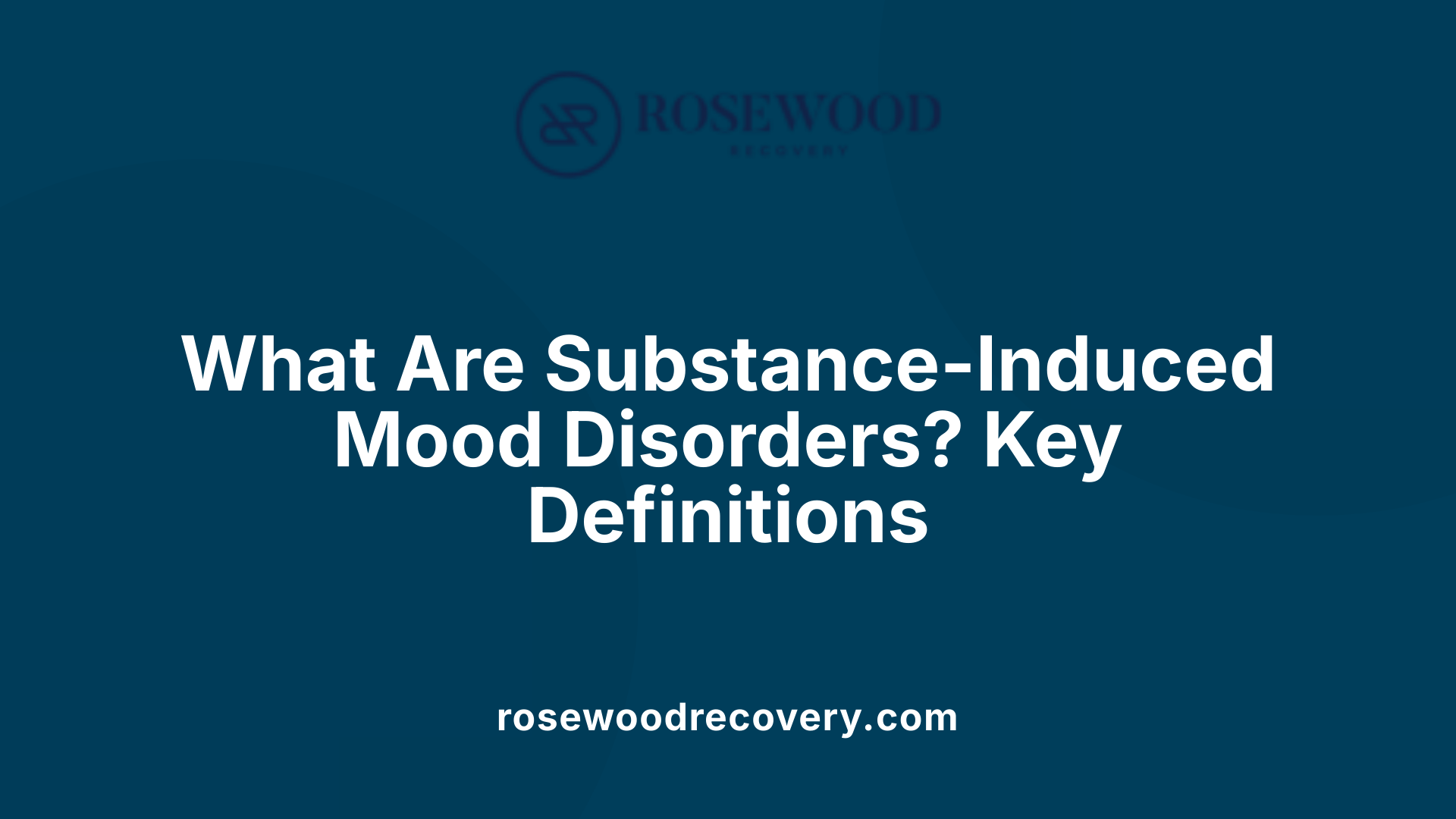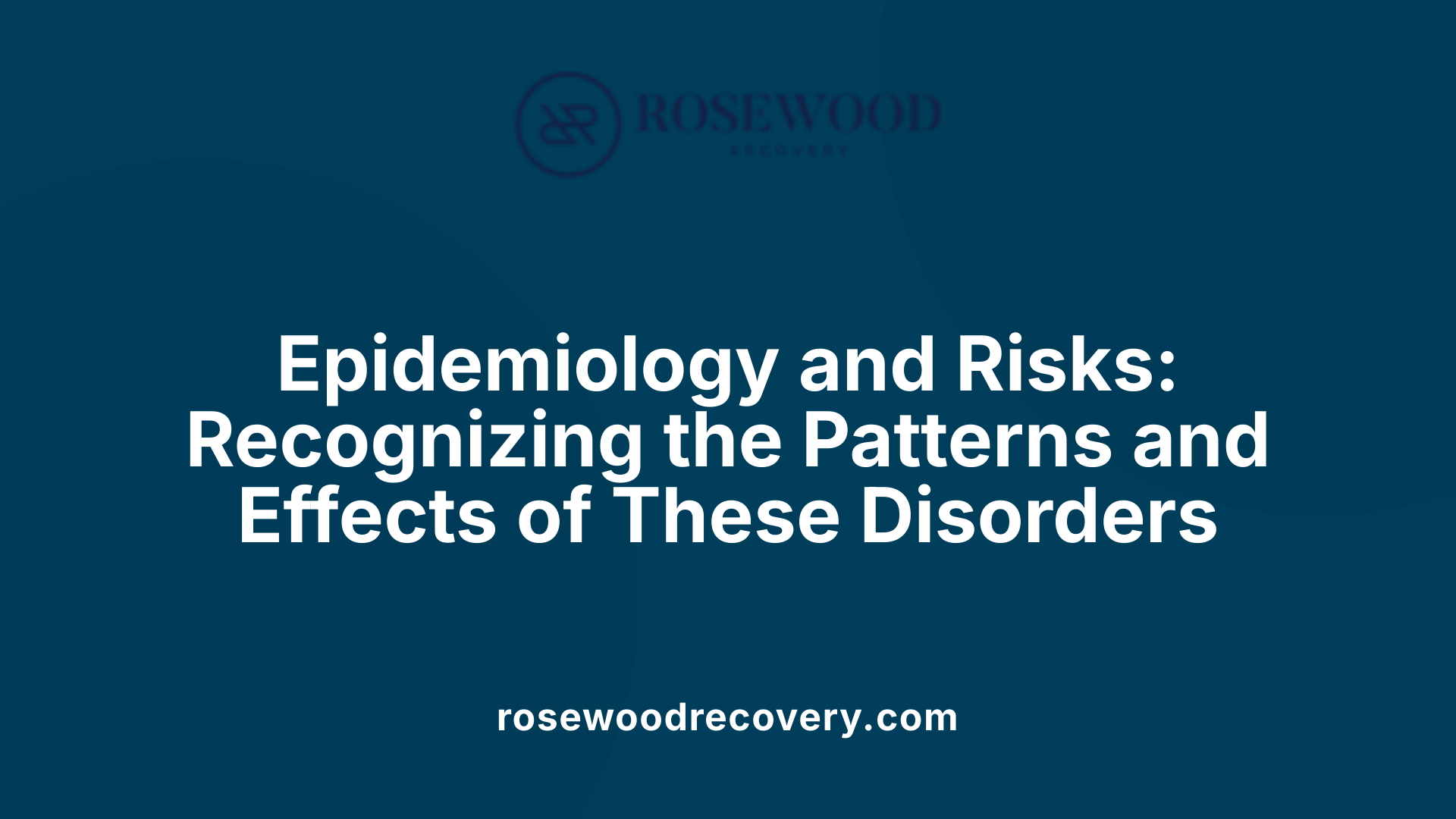An Overview of Substance-Induced Mood Disorders
Substance-induced mood disorders are a significant subset of mental health conditions where mood disturbances are directly attributable to the physiological effects of substances such as alcohol, drugs, medications, or toxins. Recognized in psychiatric classifications like DSM-5, these disorders mimic primary mood conditions including depression and bipolar disorder but are unique in their cause-effect relationship with substance use or withdrawal. Understanding the origins, symptoms, diagnosis, and treatment of these conditions is essential for effective clinical management and improved patient outcomes.
Defining Substance-Induced Mood Disorders and Their Pathophysiology

What is a substance-induced mood disorder?
A substance-induced mood disorder is a mental health condition characterized by significant, persistent disturbances in mood, emotions, or behavior that resemble depression or bipolar disorder. These mood changes are directly caused by the use, abuse, or withdrawal of substances such as alcohol, drugs, medications, or toxins, which affect the brain’s neurotransmitters and alter mood regulation. The disorder is linked to changes in brain chemistry resulting from exposure to these substances, leading to symptoms like depressed mood, mania, or irritability. Importantly, these mood disturbances are not attributable to other medical or psychiatric conditions but are specifically induced by substance use or withdrawal. Proper diagnosis involves establishing the temporal relationship between substance exposure and the onset of mood symptoms, and treatment typically involves managing both the substance use and the mood disorder itself.
What are the symptoms of substance-induced mood disorders?
Patients typically present with symptoms such as depression, euphoria, irritability, mood swings, grandiosity, impulsivity, racing thoughts, and feelings of guilt or worthlessness. These symptoms often occur during active substance use, intoxication, or withdrawal and are directly attributable to the physiological effects of substances like alcohol, opioids, stimulants, or medications.
While they can resemble primary mood disorders, substance-induced symptoms are distinguished by their temporal association with substance ingestion and their resolution following cessation. Common symptoms include prolonged depression, uncontrollable euphoria, agitation, and irritability.
Most importantly, symptoms tend to improve within days after stopping the substance, emphasizing the importance of a thorough substance use history for accurate diagnosis. Effective treatment focuses on abstinence, supportive therapies, and sometimes medications to stabilize mood.
What causes substance-induced mood disorders?
These disorders primarily result from the effects of various substances of abuse or prescribed medications on brain chemistry. Substances like alcohol, cocaine, opioids, hallucinogens, and certain medications (e.g., corticosteroids, interferon) can alter neurotransmitter systems such as serotonergic, dopaminergic, and neuropeptide pathways.
These chemical alterations disrupt normal mood regulation, leading to episodes of depression, mania, or mixed states. During intoxication, substances increase or decrease neurotransmitter activity, causing mood swings or psychotic symptoms. During withdrawal, the absence of the substance’s effects can precipitate depressive or anxious states.
The pathophysiology involves neuroplastic changes, neuroinflammation, and systemic effects on neurochemical balance. Long-term abuse can cause structural brain changes that further impact emotional regulation. Most symptoms alleviate within about a month after stopping the offending substances, underscoring the importance of prompt cessation and supportive care.
How are substance-induced mood disorders diagnosed and differentiated from primary mood disorders?
Diagnosing these disorders requires a detailed clinical assessment that links mood symptoms directly to recent substance use, intoxication, or withdrawal. According to DSM-5 criteria, key features include the onset of symptoms during or shortly after substance exposure, and symptom resolution within about a month following cessation.
Differentiating from primary mood disorders involves ruling out the independence of mood symptoms from substance use. If symptoms predate substance use or persist beyond one month after stopping the substance, a primary mood disorder may be suspected.
Laboratory tests such as blood or urine screens for substances support the diagnosis. Additionally, a thorough medical and psychiatric history helps establish the temporal relationship.
The distinction is crucial because treatment strategies differ: substance-induced episodes often resolve with abstinence, while primary disorders may require ongoing psychiatric medication and therapy.
What are the treatment options for substance-induced mood disorders?
Effective treatment begins with the immediate goal of stopping or reducing substance use, often under medical supervision to manage withdrawal symptoms. Supportive care during detox includes hydration, nutritional support, and monitoring for complications.
Psychotherapeutic interventions such as cognitive-behavioral therapy (CBT), motivational interviewing, and family therapy play a vital role in addressing underlying issues and preventing relapse.
Pharmacotherapy may be indicated for persistent depressive or manic symptoms. Antidepressants, mood stabilizers, or antipsychotics can be used to stabilize mood while supporting abstinence.
Integrated treatments targeting both mood symptoms and substance use—called dual diagnosis approaches—are considered most effective. Ongoing outpatient support, peer groups, and relapse prevention strategies enhance long-term recovery.
Are substance-induced mood disorders common, and what is their impact?
These disorders are prevalent among individuals with substance use problems. Research indicates that around 40-60% of individuals with alcohol use disorder and approximately 55% of those with opioid dependence experience substance-induced depression.
The episodes typically occur during intoxication or withdrawal and tend to resolve within a month after discontinuing substances. Their impact can be serious, contributing to impaired functioning, increased suicide risk, and complicating mental health treatment.
Recognizing and addressing these disorders is critical, as failure to do so may prolong recovery and increase the likelihood of relapse.
In conclusion, understanding the complex interplay between substances and mood regulation helps healthcare providers diagnose and treat these disorders effectively. Abstinence, combined with tailored therapies and support, offers the best chance for recovery and improved mental health.
This comprehensive insight highlights the importance of careful evaluation and integrated treatment approaches to effectively manage substance-induced mood disorders.
Prevalence, Epidemiology, and Impact of Substance-Induced Mood Disorders

Are substance-induced mood disorders common, and what is their impact?
Substance-induced mood disorders are a significant concern within mental health and addiction care, affecting a considerable portion of individuals with substance use problems. Studies indicate that a substantial percentage of those with substance use disorders experience mood disturbances directly related to their substance consumption. For instance, between 40% and 60% of individuals with alcohol use disorder report episodes of substance-induced depression. Similarly, around 55% of those with opioid use disorder encounter mood symptoms that are attributable to their substance use.
These disorders are not limited to alcohol and opioids; various substances such as cannabis, stimulants like cocaine and methamphetamines, hallucinogens, and even prescription medications like corticosteroids and certain antiepileptic drugs can trigger mood disturbances. The symptoms commonly include feelings of sadness, irritability, mood swings, euphoria, anxiety, or profound depression.
Substance-induced mood disorders may manifest during active intoxication or withdrawal phases. Notably, symptoms often commence during intoxication, intensify in withdrawal, and tend to resolve within days to weeks following cessation of substance use. However, in some cases, especially with long-term or heavy use, mood symptoms can persist, causing chronic impairment.
The impact of these disorders extends beyond individual well-being. They can impair daily functioning, jeopardize recovery from substance dependence, and elevate the risk of suicidal thoughts and behaviors. Moreover, they pose diagnostic challenges, as they can mimic primary mood disorders such as major depression or bipolar disorder, leading to potential misdiagnosis and inappropriate treatment.
Recognition of substance-induced mood disorders is vital for effective treatment planning. Interventions that focus on detoxification, combined with psychological therapies such as cognitive-behavioral therapy, and medications when appropriate, significantly improve outcomes. The prognosis largely depends on sustained abstinence, early intervention, and addressing both the substance use and the mood symptoms concurrently.
Understanding the epidemiology of these disorders allows healthcare providers to identify high-risk populations. Such populations often include individuals with a history of heavy or polysubstance use, those experiencing stressful life conditions, and patients with preexisting mental health disorders. Targeted strategies can then be developed for prevention, early detection, and comprehensive care, reducing the overall burden of substance-induced mood disturbances.
Pharmacological and Therapeutic Interventions for Management
What are the treatment options for substance-induced mood disorders?
Treating substance-induced mood disorders begins with addressing the root cause: substance use. Immediate cessation or reduction of the offending substance is crucial, as symptoms often improve significantly once exposure stops. Medical supervision during detoxification is recommended to manage withdrawal symptoms and cravings effectively.
Pharmacotherapy can be beneficial, especially when mood symptoms persist after stopping substance use. Antidepressants, such as selective serotonin reuptake inhibitors (SSRIs), are commonly prescribed to treat residual depressive symptoms. For manic or psychotic features, second-generation antipsychotics like quetiapine or olanzapine may be used.
Psychotherapeutic strategies are also vital. Cognitive-behavioral therapy (CBT), family therapy, and motivational enhancement therapy are effective in helping individuals understand their substance use patterns, develop coping skills, and build motivation for ongoing recovery.
Holistic approaches and support therapies play a supportive role in treatment. These include lifestyle modifications, mindfulness practices, and participation in support groups such as Alcoholics Anonymous or Narcotics Anonymous. Such programs encourage ongoing abstinence, relapse prevention, and social support.
Overall, a comprehensive, evidence-based dual diagnosis approach that treats both mood symptoms and substance use disorder offers the best chance for lasting recovery and functional improvement.
Are pharmacological treatments effective in managing co-occurring disorders?
Medications can be effective components of managing co-occurring substance use and mood disorders when integrated into a broader treatment plan. Pharmacological interventions need to be carefully tailored to each individual, considering their substance history, psychiatric symptoms, and possible medication interactions.
Antidepressants, such as SSRIs or serotonin-norepinephrine reuptake inhibitors (SNRIs), help mitigate depressive symptoms during recovery. Antipsychotics like quetiapine and olanzapine are used for mood stabilization and to control psychosis or severe agitation linked to withdrawal or mental health conditions.
Emerging approaches involve personalized medicine strategies, including genetic testing, to identify the most effective medication options for individual responses. For example, research into polymorphisms such as those in the OPRM1 gene suggests potential pathways for more targeted treatments in alcohol dependence.
Despite their benefits, pharmacotherapy alone is insufficient. Successful management typically depends on combined treatment strategies that include therapy, support groups, and social services. Continued abstinence and behavioral change are key factors influencing medication efficacy.
Current research advocates a holistic approach, emphasizing the importance of combining medications with psychosocial interventions to optimize outcomes. Ongoing studies aim to refine these strategies, making treatment more personalized and effective for those battling both substance dependence and mood disturbances.
Final Insights and Future Directions
Understanding substance-induced mood disorders involves recognizing the complex interplay between substances, brain chemistry, and Mood regulation. Accurate diagnosis hinges on careful assessment of substance use history and symptom timeline, distinguishing these conditions from primary mood disorders. Effective treatment combines substance cessation, supportive therapies, pharmacological management, and ongoing mental health support. As research advances, personalized medicine approaches and novel pharmacotherapies hold promise for improved outcomes. Increased awareness and comprehensive care strategies are essential to mitigate the substantial individual and societal impacts of these disorders. Continued investigation will be crucial to optimize interventions and support recovery in affected individuals.
References
- Substance-Induced Mood Disorders - StatPearls - NCBI Bookshelf
- What Is A Substance-Induced Mood Disorder?
- What Happens in Substance-Induced Mood Disorder? - Verywell Mind
- Substance/Medication-Induced Mood Disorder - Yale Medicine
- Substance-induced mood disorder: Effects, treatment, and more
- What is Substance Induced Mood Disorder? | Pyramid Healthcare NC
- Current Status of Co-Occurring Mood and Substance Use Disorders
- Substance Induced Mood Disorder - Crest View Recovery Center

.jpeg)


